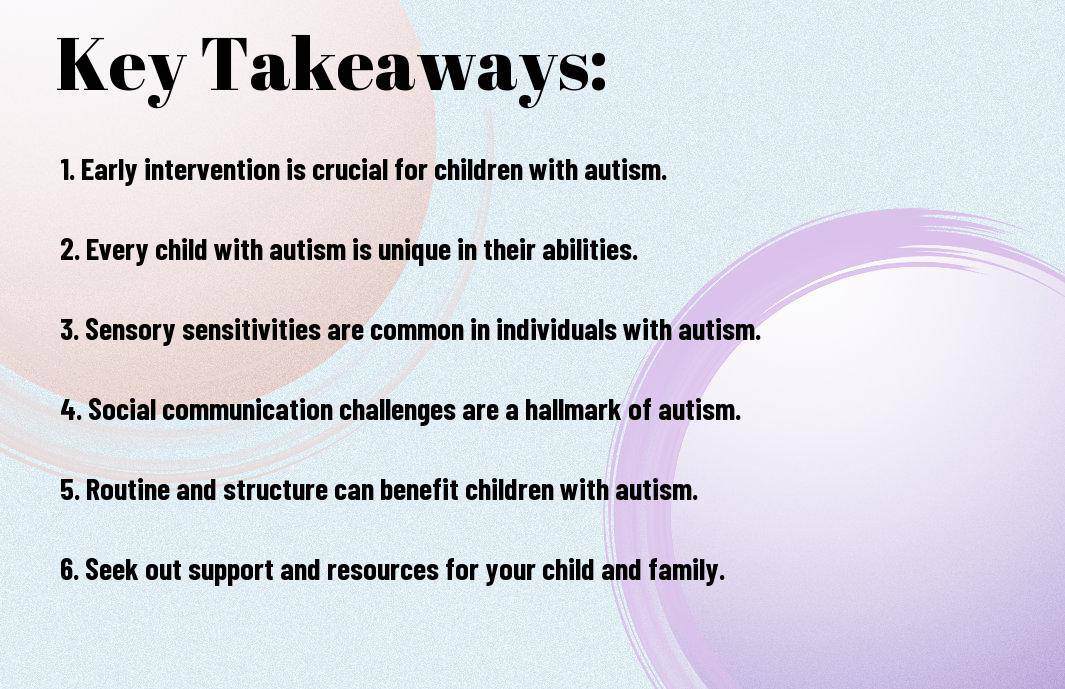Autism Spectrum Disorder (ASD) is a complex developmental condition that affects individuals in different ways. For new parents, understanding the basics of ASD is crucial in providing the best support and care for their child. From recognising early signs to accessing appropriate interventions, this blog post aims to provide an insightful overview of ASD for new parents. It is essential to educate yourself about the disorder and seek professional guidance to effectively navigate the challenges and celebrate the strengths of individuals with ASD. As a complex neurodevelopmental condition, understanding the basics of ASD is the first step towards empowering new parents to provide the best possible support for their child.
Key Takeaways:
- Early intervention is crucial for children with Autism Spectrum Disorder (ASD) to help them develop important skills and improve their quality of life.
- Understanding individual strengths and challenges of children with ASD is important for creating tailored strategies and support systems for their development.
- Building a support network and seeking professional guidance can help new parents navigate the complexities of raising a child with ASD.
 <
<
The Signs and Symptoms
<
Recognizing Early Indicators
Early indicators of Autism Spectrum Disorder (ASD) may present themselves in the first few years of a child’s life. These can include delayed language development, social communication challenges, repetitive behaviours, and sensory sensitivities. Parents may notice that their child is not reaching typical developmental milestones, such as making eye contact, responding to their name, or engaging in pretend play. It is important for parents to be attentive and observant to these potential indicators and seek professional evaluation if they have concerns.
Differences Across the Spectrum
ASD is a spectrum disorder, which means that every individual with autism will display unique characteristics and traits. These differences can range from mild to severe, resulting in varying levels of support and intervention required. Some individuals may have exceptional abilities in certain areas, such as mathematics or music, while experiencing considerable challenges in other areas. Understanding these diverse presentations of autism is crucial for parents as it can guide them in providing tailored support and interventions that best meet their child’s needs.
It is important to understand that there is no one-size-fits-all approach to autism. Each individual with ASD will have their own unique set of strengths and challenges, and it is essential to recognise and appreciate these differences in order to provide the most effective support.
Seeking Professional Help
Seeking professional help is a crucial step for parents who suspect their child may be on the autism spectrum. A timely and accurate diagnosis can lead to effective intervention strategies that can greatly benefit the child’s development and overall well-being.
Choosing the Right Specialists
When seeking professional help for your child, it’s important to choose specialists who have experience and expertise in diagnosing and treating autism spectrum disorder. Look for professionals such as child psychologists, developmental paediatricians, or child psychiatrists, who have a thorough understanding of the complexities of ASD. Additionally, consider seeking out professionals who are familiar with the specific needs of your child, as well as any co-occurring conditions that may be present.
What to Expect from an Assessment
During an assessment for autism spectrum disorder, you can expect the specialist to conduct a comprehensive evaluation of your child’s developmental history, behaviours, and communication skills. The assessment may also involve observing your child in various settings and conducting standardised tests to gain a better understanding of their strengths and challenges. The information gathered from the assessment will help the specialist form a diagnosis and provide recommendations for intervention and support.
In some cases, additional assessments may be recommended to further understand specific areas of difficulty, such as sensory processing or intellectual functioning. It’s important to be prepared for the assessment process and to provide the specialist with as much information about your child’s behaviour and development as possible.

Therapies and Interventions
Overview of Treatment Options
There are a range of therapies and interventions available for children with Autism Spectrum Disorder (ASD). These can include behavioural therapies, speech and language therapy, occupational therapy, and social skills training. Each child’s needs are unique, so it’s essential to work closely with professionals to determine the most appropriate treatment plan.
Supporting Your Child at Home and in School
Supporting your child at home and in school is crucial for their development and well-being. This may involve creating a structured and predictable environment, providing clear instructions and expectations, and collaborating with school staff to implement supportive strategies. It’s important to advocate for your child’s needs and ensure they have access to appropriate educational resources.
Parents can also benefit from seeking out parent training programmes to gain skills and strategies for supporting their child’s unique needs at home and in the community.
Navigating Daily Life
When it comes to navigating daily life with a child on the autism spectrum, it’s important to understand their unique needs and challenges. From communication and social interaction strategies to creating a structured environment, there are several ways to support your child in their daily routines.
Communication and Social Interaction Strategies
Children with Autism Spectrum Disorders (ASD) may struggle with communication and social interaction. It’s important to create clear, consistent communication strategies that cater to their individual needs. This could include using visual aids, social stories, and role-playing exercises to help them navigate social situations. Additionally, seeking out therapy and support groups can provide valuable resources for both you and your child.
Creating a Structured Environment
Creating a structured environment can help children with ASD feel more secure and in control. This may involve establishing routines, setting clear expectations, and providing ample sensory breaks. By creating a predictable environment, you can help reduce anxiety and meltdowns, allowing your child to thrive in their day-to-day activities.
For more in-depth information on creating a structured environment for a child with Autism Spectrum Disorder, you can refer to Autism Spectrum Disorders (ASD).
Overall, it’s crucial to understand that every child is unique, and what works for one may not work for another. It’s essential to remain patient, flexible, and open-minded as you navigate daily life with your child on the autism spectrum.

Looking Ahead
As you navigate the world of parenting a child with autism spectrum disorder, it’s important to also look ahead to the future. While it may feel overwhelming at times, being proactive and prepared can make a significant difference in your child’s journey.
Preparing for Adolescence and Adulthood
As your child with autism spectrum disorder grows older, it’s crucial to start considering the transition to adolescence and adulthood. This may involve exploring educational and vocational opportunities, as well as the development of social and life skills. Seeking support from professionals and connecting with other parents who have gone through similar experiences can be invaluable in preparing for the future.
Fostering Independence and Advocacy
Another important aspect to consider is fostering independence and advocacy in your child. Encouraging self-care, decision-making, and problem-solving skills can help your child become more self-sufficient. Additionally, teaching your child to self-advocate and understand their rights can empower them to navigate the world with confidence.
By fostering independence and advocacy, you can equip your child with the tools they need to lead fulfilling and meaningful lives. This includes promoting self-determination, teaching them to express their needs and preferences, and advocating for their rights in various settings. Empowering your child to advocate for themselves can help them navigate challenges and embrace their strengths.
Understanding Autism Spectrum Disorder – Basics for New Parents
In conclusion, gaining a foundational understanding of Autism Spectrum Disorder is important for new parents in order to effectively support their child. By learning about the common characteristics, potential challenges, and available resources, parents can make informed decisions and provide the best possible care for their child. It is essential to seek professional guidance and support while navigating the complexities of ASD, and to approach the journey with patience, empathy, and an open mind. Educating oneself about ASD is the first step towards creating a nurturing and inclusive environment for children on the spectrum, and it is a crucial part of advocating for their overall well-being and success.
Understanding Autism Spectrum Disorder – Basics for New Parents
Q: What is Autism Spectrum Disorder (ASD)?
A: Autism Spectrum Disorder is a developmental disorder that affects communication, social interaction, and behaviour. It is a spectrum condition, meaning that individuals with ASD can have a wide range of symptoms and levels of impairment.
Q: What are the common signs of ASD in children?
A: Common signs of ASD in children include difficulties with social interaction, delayed speech and language skills, repetitive behaviours, intense focus on certain interests, and sensitivity to sensory input such as sound or touch.
Q: How is ASD diagnosed?
A: ASD is typically diagnosed through a comprehensive assessment by a team of professionals, including psychologists, paediatricians, and speech therapists. The assessment may involve observation of the child’s behaviour, developmental history, and standardized testing.
Q: What are the treatment options for children with ASD?
A: Treatment for ASD often involves a combination of behavioural therapies, speech and language therapy, occupational therapy, and in some cases, medication to manage certain symptoms. Early intervention is key in helping children with ASD reach their full potential.
Q: How can parents support a child with ASD?
A: Parents can support their child with ASD by seeking out specialised services and therapies, creating a structured and predictable environment, advocating for their child’s needs in educational settings, and connecting with support groups and other families affected by ASD.
Q: What are the challenges for families of children with ASD?
A: Families of children with ASD may face challenges such as navigating the healthcare and educational systems, managing behavioural issues, and coping with the emotional impact of having a child with special needs. It is important for families to seek out support and resources to help them cope.
Q: What is the long-term outlook for individuals with ASD?
A: The long-term outlook for individuals with ASD varies greatly depending on the severity of their symptoms and the effectiveness of early intervention and support. With the right resources and interventions, many individuals with ASD can lead fulfilling and independent lives as adults.







